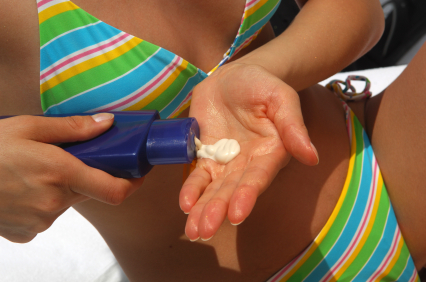Guest Blog Post: Sun Survival for Summer’s Arrival
 Using sunscreen can be an effective way to prevent skin damage that can lead to cancer. Make sure you know how to use it correctly!
Using sunscreen can be an effective way to prevent skin damage that can lead to cancer. Make sure you know how to use it correctly!Today, CancerCare intern and guest blogger Breana McDonald shares some important tips about preventing skin cancer, especially during the sunny summer months. Breana currently attends The Hill School in Pottstown, PA, and she is interested in becoming an oncologist.
It’s that time of year again! The weather is nice and the sun is blazing, but it’s important to remember that too much exposure to the sun’s ultraviolet (UV) rays can damage your skin and act as a major cause of skin cancer. The good news is that you can make small changes to your daily life to prevent skin damage and detect signs of skin cancer early.
First, sunscreen can be very effective if used correctly, so make sure you know the right way to use it. It is best to reapply sunscreen at least every two hours, regardless of the SPF. If you are swimming or sweating you should reapply it more often because even water-resistant sunscreen is not water proof. Second, choose a sunscreen that says “broad spectrum.” It protects against two types of UV rays that cause skin cancer. Also, use sunscreen with at least an SPF of 30 and remember to cover places such as ears, eyelids, lips, nose, hands, feet and forehead.
In addition to using sunscreen, there are other actions you can take to protect against harmful UV rays:
- Seek shade or avoid sun from 10am—4pm when sun exposure is greatest (even on cloudy days)
- Wear a wide-brimmed hat to shade your eyes, ears and head
- Wear chapstick with SPF because lips have the thinnest layer of skin, and are 12 times more likely to be exposed
- Wear wrap-around sunglasses with at least 99% UV protection since the eyelid region is a common site for skin cancer
- Wear lightweight, loose-fitting clothing to cover and protect large portions of your body (e.g. long pants or long-sleeved shirts). Tight-woven fabrics are best
 To avoid skin damage when you're out in the sun, wear a wide-brimmed hat to shade your eyes, ears and head
To avoid skin damage when you're out in the sun, wear a wide-brimmed hat to shade your eyes, ears and headYou can also detect possible signs of skin cancer early. The best way is to receive a professional skin examination annually by a dermatologist and to perform a self-examination monthly. Self-examinations can be quick, easy, and you only need three things: a mirror, your eyes, and the mnemonic ABCD. Your ABCD’s will be the way you examine any moles. They are:
- A: Asymmetrical --> Is your mole oddly shaped?
- B: Border --> Does the mole have irregular or vaguely defined borders?
- C: Color --> Does the move have uneven coloring or multiple colors?
- D: Diameter --> Is the mole larger than a pencil eraser? Is it growing in size?
If you have any moles meeting the ABCD criteria, get checked by a dermatologist and track your moles to see if any changes occur. To make it easier, perform self-examinations in a well-lit room in front of a full-length mirror and use a handheld mirror areas that are small or difficult to see (e.g. ears, neck, underarms, and between your toes and fingers). Double-check common places for skin cancer, which include your face, calves/legs, hands, chest and back.
Enjoy the outdoors and summer but also enjoy practicing sun safety!
